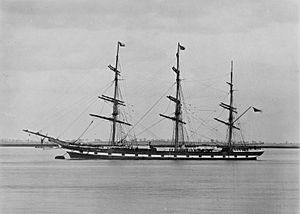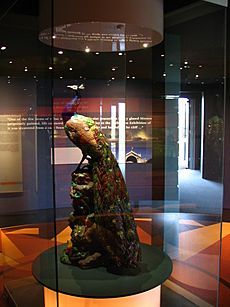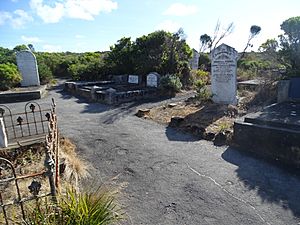Loch Ard (ship) facts for kids
 |
|
Quick facts for kids History |
|
|---|---|
| Name | Loch Ard |
| Namesake | Loch Ard, Scotland |
| Owner | General Shipping Co |
| Operator | James Aitken |
| Port of registry | Glasgow |
| Builder | Charles Connell & Co, Scotstoun |
| Yard number | 87 |
| Launched | 8 November 1873 |
| Maiden voyage |
|
| Identification | |
| Fate | Wrecked 1 June 1878 |
| General characteristics | |
| Type | Clipper |
| Tonnage | 1,693 GRT, 1,624 NRT |
| Length | 262.7 ft (80.1 m) |
| Beam | 38.3 ft (11.7 m) |
| Depth | 23.0 ft (7.0 m) |
| Propulsion | sail, three masts |
| Sail plan | full-rigged ship |
| Crew | 17 |
| Notes | Gave her name to Loch Ard Gorge, where she was wrecked. |
The Loch Ard was a fast sailing ship, called a clipper, built in Scotland in 1873. It was made of iron, which was quite modern for its time. Sadly, it was wrecked off the Shipwreck Coast in Australia in 1878.
Contents
Building a Famous Clipper Ship
The Loch Ard was built by Charles Connell & Co. in Glasgow, Scotland. This company made ships for the Loch Line. The Loch Line was a shipping company that sailed between Great Britain and Australia.
The ship was launched on November 8, 1873. It was 262.7 feet (about 80 meters) long. It was 38.3 feet (about 11.7 meters) wide and 23.0 feet (about 7 meters) deep. The Loch Ard had three masts and was a full-rigged ship. This meant it had square sails on all three masts.
The ship was named after Loch Ard in Scotland. A loch is a lake. The name means "high lake" in Scottish Gaelic. The place where the ship wrecked, Loch Ard Gorge, was named after the ship.
The Challenging First Voyage
The Loch Ard's first trip from Glasgow to Melbourne was very tough. In December 1873, just days after leaving Glasgow, strong winds broke some of its masts. The ship had to turn back for repairs.
It left Glasgow again on January 26, 1874. But on April 2, a huge storm in the Southern Ocean broke all three of its masts. The crew worked hard for four days to fix temporary masts. They also had to pump out water from the ship. Despite all the damage, the Loch Ard finally reached Melbourne on May 24.
The Final Journey and Tragic Wreck

The Loch Ard began its last voyage on March 1, 1878. It left Gravesend, England, heading for Melbourne. On board were Captain George Gibbs, 37 crew members, and 17 passengers. This made a total of 54 people. The ship carried many different goods.
On June 1, the ship was close to Melbourne. The crew expected to see land, but thick fog covered everything. The captain couldn't see the Cape Otway lighthouse. His clocks, called chronometers, were not working correctly. Also, bad weather for several days meant he couldn't figure out the ship's exact location. Because of this, Captain Gibbs didn't know how close they were to the coast.
Around 4 AM, the fog lifted. Suddenly, the crew saw huge waves crashing against tall cliffs. Captain Gibbs quickly ordered the sails to be set to turn the ship around. He wanted to get away from the dangerous coast. But it was too late. The ship hit a hidden reef. The masts and ropes crashed down, hurting some people on deck. The lifeboats couldn't be launched properly. The Loch Ard sank very quickly, in just 10 to 15 minutes after hitting the reef.
Many people believe Captain Gibbs thought the nearby Loch Ard Gorge was the entrance to Port Phillip Heads. However, this is not true. The two places look very different. Also, ships had to stop outside Port Phillip Heads to pick up a special pilot. The Loch Ard never even entered the Gorge.
The Two Survivors
Only two people survived the shipwreck: Eva Carmichael and Thomas Pearce. Eva held onto a piece of wood from the ship for five hours. Thomas, who was an apprentice, clung to the bottom of an overturned lifeboat.
Thomas reached the shore first. Then he heard Eva calling for help. He bravely went back into the ocean to rescue her. They both came ashore at the place now known as Loch Ard Gorge. They found shelter there before getting help. Thomas Pearce's stepfather was also a ship captain whose ship, the SS Gothenburg, had been wrecked in 1875.
Amazing Items Found from the Wreck

The Loch Ard's cargo included many fancy items. One was a grand piano that later washed up in the Gorge. Another special item was a large, beautiful porcelain peacock. It was made by Minton in England. This peacock was meant to be shown at the Melbourne International Exhibition in 1880.
Luckily, the peacock was found whole. It was later displayed at the Brisbane 1988 World Exposition. Today, you can see the Loch Ard Peacock at the Flagstaff Hill Maritime Museum in Warrnambool, Victoria. The museum also has other items recovered from the shipwreck.
Exploring the Wreck Site
The remains of the Loch Ard lie about 25 meters (82 feet) deep in the ocean. It is a popular place for wreck diving. Divers need to be experienced to explore this site.
See also
- List of disasters in Australia by death toll


